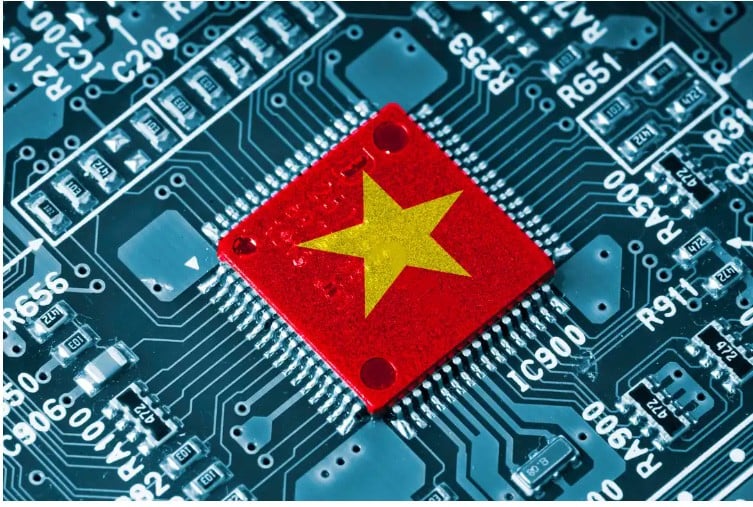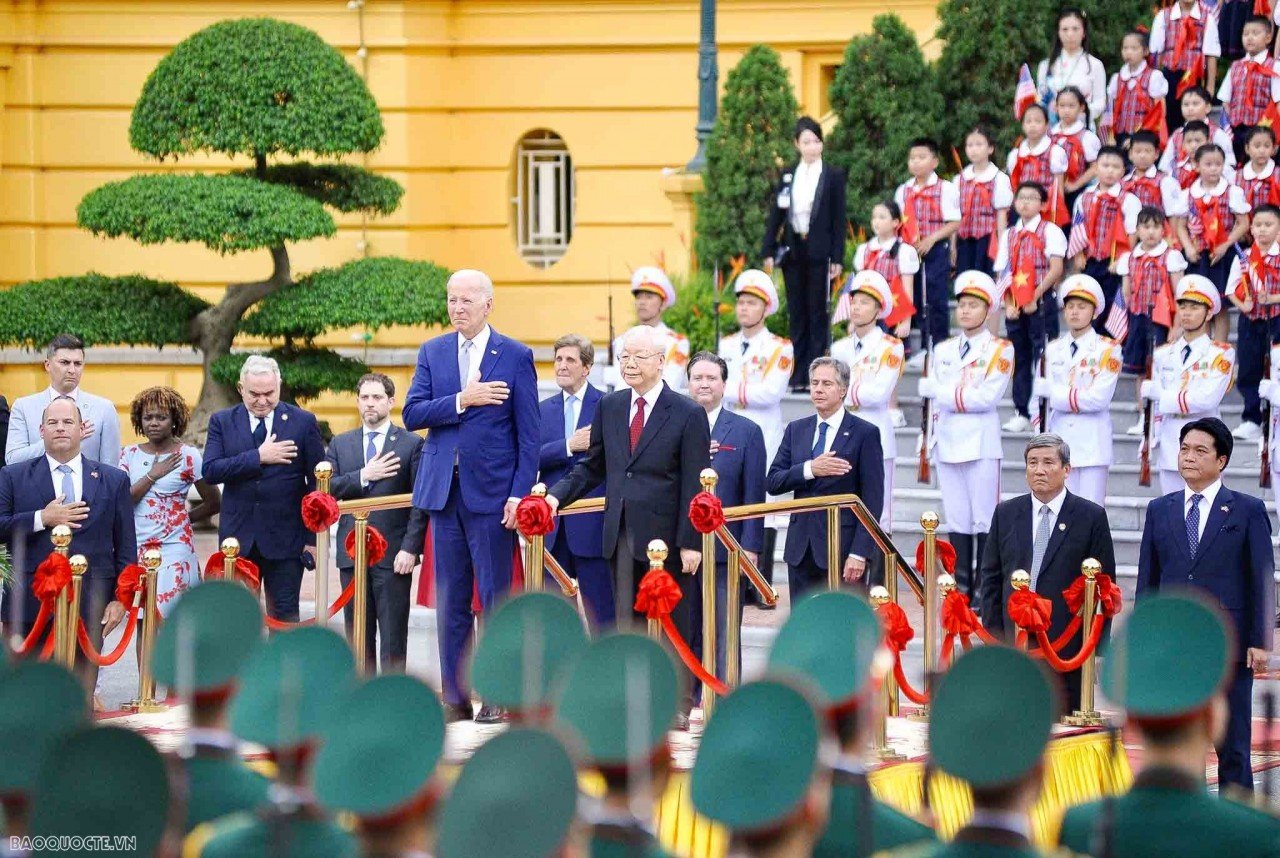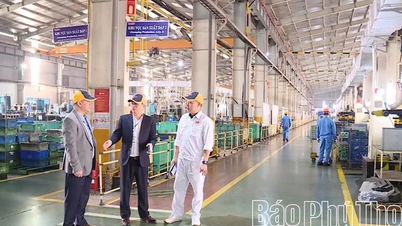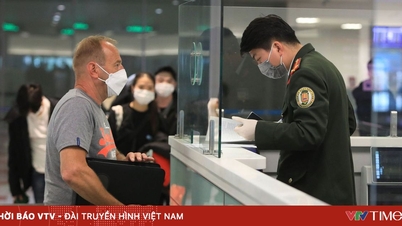 |
| The image shows the Vietnamese flag on the electronic circuit board of a key smartphone component. (Source: Getty Images) |
Unlocking Vietnam's economic potential
Seeking Alpha , a website specializing in financial market news, published an article titled "Unlocking Vietnam's Economic Potential," noting that Vietnam is becoming an increasingly attractive investment destination thanks to its strong GDP growth, advancements in high-tech manufacturing capabilities, and strong relationship with the United States.
This information page has “ discovered ” what makes Vietnam an attractive investment destination: the resilience of its economy, its upward movement in the value chain, strong foreign investment, and significant potential in strategic materials and semiconductors.
The news report suggests that the Southeast Asian nation's economy has been quite resilient despite setbacks from rising commodity prices due to the Russia-Ukraine conflict and a slowdown in China, one of Vietnam's largest trading partners. Vietnam's GDP grew by 8.0% in 2022, benefiting from increased commodity exports during the Covid-19 pandemic. The economy remained stable at 5.3% GDP growth in the third quarter of 2023 compared to the same period the previous year. Vietnam's trade faced some headwinds this year due to reduced demand from major trading partners. Exports fell by 10% in the first eight months of 2023 compared to the same period the previous year, but ultimately rebounded in September.
Seeking Alpha commented that the Vietnamese government is acutely aware of this challenge and is actively trying to attract foreign investment into high-tech manufacturing, especially in the semiconductor sector. The country has signed numerous Free Trade Agreements (FTAs) and implemented support measures such as tax incentives, preferential loan interest rates, import duty exemptions, and preferential land use fees for high-tech factories.
Strong government support appears to have yielded some initial results. Vietnam has achieved impressive growth in electronics exports, particularly to the United States. From almost zero, Vietnam now accounts for approximately 10% of total US electronics imports.
In addition, despite facing a challenging environment due to slowing growth and declining export performance, Vietnam has still attracted $15.9 billion in foreign direct investment (FDI) since the beginning of the year.
The manufacturing sector continues to be a major attraction for FDI, with year-to-date investments exceeding US$14 billion, a 15.5% increase year-on-year. This achievement is significant given the current instability, inflationary pressures, and declining confidence in the global economic outlook. Apple's key suppliers, such as Foxconn Technology Group (OTCPK:FXCOF), GoerTek Inc., Luxshare Precision Industry Co., and Pegatron Corp., have established factories in Vietnam, bringing the electronics sector's share of total exports to 32% in 2022.
Furthermore, Vietnam possesses the world's second-largest reserves of rare earth elements, estimated at around 22 million tons, second only to China. The country's rare earth industry is booming, with production reaching 4,300 tons in 2022, an approximately 11-fold increase from the 400 tons produced in 2021. The country aims to increase rare earth production to 2.02 million tons per year by 2030.
Foreign companies, including South Korean and Chinese magnet manufacturers, among them Apple supplier AAPL, are preparing to open factories in Vietnam to diversify their supply chains away from China.
Recently, the United States signed the U.S.-Vietnam Comprehensive Economic Partnership Agreement to enhance cooperation between the two countries on a broad scale. Notably, the U.S. committed an initial $2 million in funding to launch initiatives to develop the semiconductor workforce in Vietnam. Semiconductors are a critical component in many different technologies, and this collaboration aims to elevate Vietnam's position in the global semiconductor supply chain, demonstrating the important role Vietnam is willing to play in the industry's growth.
The report concludes that Vietnam is on the verge of a dynamic economic transformation, demonstrating impressive resilience, attracting foreign investment, and driving growth in high-value sectors. With significant rare earth reserves and a burgeoning semiconductor industry, Vietnam is poised to become a key player in the global supply chain. The strong partnership between the United States and Vietnam further strengthens the country's position in the global economy.
Investors seeking growth opportunities should keep an eye on Vietnam as the country moves up the value chain and expands its presence in strategic sectors, making it an attractive investment destination.
The story of rapid growth.
Previously, MoneyWeek, one of the leading financial magazines in the UK, also published an analysis of Vietnam's growth story.
This magazine argues that milestones such as the implementation of the "Doi Moi" (Renovation) policy in December 1986, joining the Association of Southeast Asian Nations (ASEAN) in 1995, the normalization of relations between Vietnam and the United States in 2000, and Vietnam's accession to the WTO in 2007, along with policies promoting participation in a series of trade agreements, have transformed Vietnam from one of the poorest countries in the world into a middle-income country, with GDP per capita increasing 3.6 times in the two decades after 2002. In 1986, exports of goods and services accounted for less than 7% of Vietnam's GDP, which increased to 93% in 2021.
 |
| General Secretary Nguyen Phu Trong welcomes President Joe Biden during his visit to Vietnam in September 2023. (Photo: Nguyen Hong) |
Vietnam has experienced three distinct booms in foreign investment. The first was in the mid-1990s when Japan's Honda Motor began "local production of two-wheelers" and global sportswear brands started building factories in Vietnam. Then, the early 2000s saw technology companies from other parts of Asia setting up production lines for simple electronic devices. And the third, in the mid-2010s, as local incomes rose, it began attracting foreign retail businesses, such as the Japanese giant Aeon.
The effect of these booms is that they have transformed Vietnam into an "export powerhouse." Author Jeff Prestridge reported in the Mail on Sunday that: "More than half of Nike's shoes and 60% of Samsung's phones are manufactured in Vietnam."
According to MoneyWeek , Vietnam is currently planning to shift from the labor-intensive textile and electrical assembly industries to more profitable sectors, such as semiconductors.
According to the magazine, foreign investment will continue to be a major driver supporting market transformation amid increasing pressure to diversify supply chains away from China. Historically, US investment has been more limited compared to Japan and South Korea, but President Joe Biden's visit to Hanoi last September and the upgrading of relations to a "Comprehensive Strategic Partnership" will give the "green light" for increased US investment in Vietnam.
Vietnam's competitive advantage is "obvious," the magazine quoted Andy Ho, CEO and Head of Investment at VinaCapital, as telling The Sunday Times. Factory wages are "less than half of what they are in China, while the quality of labor is comparable in many sectors." The country also has a geographical location close to key technology supply chains in southern China. Approximately 75% of the material costs in a typical smartphone are made up of the combined cost of printed circuit boards, camera modules, touchscreens, and glass covers. Vietnamese manufacturers can source most of these parts from elsewhere in Asia with zero tariffs, thanks to the country's network of free trade agreements. Meanwhile, their Indian counterparts face customs duties of up to 22%.
MoneyWeek suggests that Vietnam has been dubbed the new Asian tiger, reminiscent of the rapid development of South Korea, Taiwan (China), Hong Kong (China), and Singapore in the latter half of the 20th century. Vietnamese investors have reason to expect that the country can emulate these earlier "tigers" and move into the group of high-income countries – defined by the World Bank as those with a gross national income per capita exceeding US$13,845.
Source



![[Photo] Prime Minister Pham Minh Chinh receives the Governor of Tochigi Province (Japan)](/_next/image?url=https%3A%2F%2Fvphoto.vietnam.vn%2Fthumb%2F1200x675%2Fvietnam%2Fresource%2FIMAGE%2F2025%2F12%2F16%2F1765892133176_dsc-8082-6425-jpg.webp&w=3840&q=75)
![[Live] 2025 Community Action Awards Gala](/_next/image?url=https%3A%2F%2Fvphoto.vietnam.vn%2Fthumb%2F1200x675%2Fvietnam%2Fresource%2FIMAGE%2F2025%2F12%2F16%2F1765899631650_ndo_tr_z7334013144784-9f9fe10a6d63584c85aff40f2957c250-jpg.webp&w=3840&q=75)
![[Image] Leaked images ahead of the 2025 Community Action Awards gala.](/_next/image?url=https%3A%2F%2Fvphoto.vietnam.vn%2Fthumb%2F1200x675%2Fvietnam%2Fresource%2FIMAGE%2F2025%2F12%2F16%2F1765882828720_ndo_br_thiet-ke-chua-co-ten-45-png.webp&w=3840&q=75)
![[Photo] Prime Minister Pham Minh Chinh receives Lao Minister of Education and Sports Thongsalith Mangnormek](/_next/image?url=https%3A%2F%2Fvphoto.vietnam.vn%2Fthumb%2F1200x675%2Fvietnam%2Fresource%2FIMAGE%2F2025%2F12%2F16%2F1765876834721_dsc-7519-jpg.webp&w=3840&q=75)







































































































Comment (0)